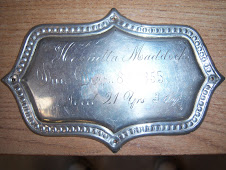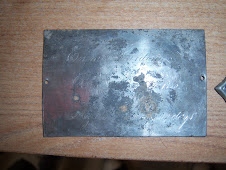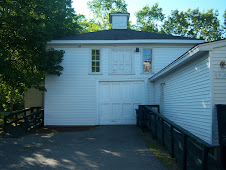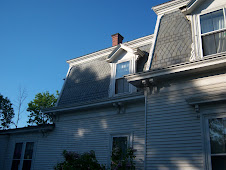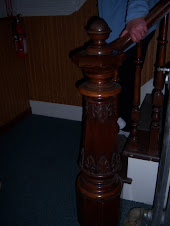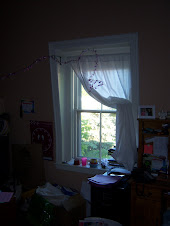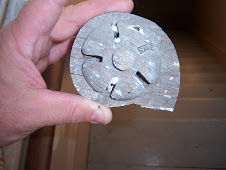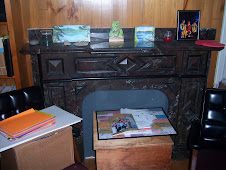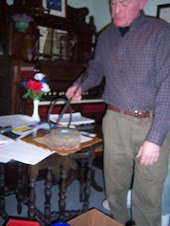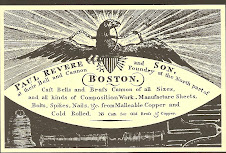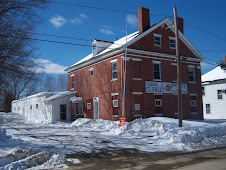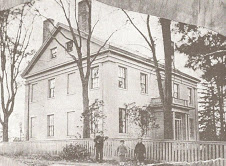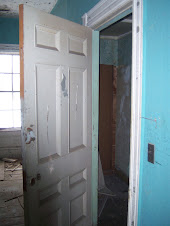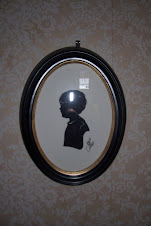THE BREWER HISTORICAL SOCIETY HAS A NEW WEBSITE
PLEASE GO TO: www.brewerhistoricalsociety.org
Friday, December 10, 2010
Sunday, November 15, 2009
The Titanic Story, by David Hanna
Captain James Weeks, Professor Emeritus at Maine Maritime Academy, used a surgeon's skill to cut through the events that engulfed the passengers of the ill-fated ship Titantic on April 15th of 1912. Utilizing models that he had created, schematics and disgrams, Captain Weeks showed in detail how the luxury liner hit the iceberg that was to her doom and how the North Sea engulfed the ship until finally, in the early morning of the 15th, she slipped below the waves with a loss of life of over 1500 people. He explained how the lifeboats were half empty and how the ship, Carpathia, heroically led the rescue of those who survived.
There are some passenger ties to Maine. Jack Thayer, a teenager on board, was ultimately proved to be correct in his assertion that the ship broke in two despite the insistence by a ship's officer that it hadn't. Jack Thayer's granddaughter presently lives in Maine. In addition there was a member of the audience whose grandmother was a survivor. He recounted how the half-empty lifeboat would not return for floundering passengers either because the officer was afraid that the sinking ship would pull her under or because the scrambling of the boarding passengers might capsize her.
Captain Weeks said that there were two Titantics---the real Titantic and the Hollywood Titantic. No matter which Titantic you follow, there is the adventure and heroism and sacrifice of over 2200 human beings on that night to remember.
There are some passenger ties to Maine. Jack Thayer, a teenager on board, was ultimately proved to be correct in his assertion that the ship broke in two despite the insistence by a ship's officer that it hadn't. Jack Thayer's granddaughter presently lives in Maine. In addition there was a member of the audience whose grandmother was a survivor. He recounted how the half-empty lifeboat would not return for floundering passengers either because the officer was afraid that the sinking ship would pull her under or because the scrambling of the boarding passengers might capsize her.
Captain Weeks said that there were two Titantics---the real Titantic and the Hollywood Titantic. No matter which Titantic you follow, there is the adventure and heroism and sacrifice of over 2200 human beings on that night to remember.
Marketing the Historical Society in a New Era, by Robert Schmick
Having visited more than my fair share of museums, historical societies, and historic houses, I have become aware of some of the challenges that especially smaller institutions face in the wake of ever increasing competition for the time of their potential audiences. Not only has television, mass media, and electronic media changed the publics’ recreational activities, but for-profit corporations have taken on an increasing role in developing exhibitions, cultural programming, and edutainment in more densely populated areas that continue to overshadow and threaten especially small institutions with small budgets. This competition has made it necessary for small cultural institutions like the local historical society to focus directly on marketing strategies. Marketing, with its traditions of competition, has often been seen by the museum community as something for them to resist, but, such strategies can make an institution greater at serving a larger portion of their community.
Successful marketing strategies are founded on an understanding of the public and their needs, or perceived needs. Small institutions, like the local historical society, need to step up to the plate and deliver new and attractive ways of presenting themselves. They must drive the point home that they are the real thing, a place where meaningful objects and trustworthy information can be found and serve a role in their lives and their community. In doing this they negate all the fears about taking on the agenda of marketing. They also need to embrace history of more than the elite of the past, present other periods in history than merely the distant past, and, finally, take on the untraditional role of documenting and presenting their community’s more recent past through the mediums of our own time---digital photography and audio in order to more effectively disseminate the information they have, namely much of their collections that are in storage for long periods of time, and become more relevant to generations that have embraced new digital media.
Taking on the point of view of visitors, or potential visitors, may mean that the local historical society must transcend merely the historical narratives of the 17th-19th centuries and seek to satisfy the current demand for twentieth century nostalgia by baby boomers, Gen-Xers, and the like. This could be a strategy that will result in drawing more people into the institution’s fold for further growth and initiate some needed enthusiasm among greater numbers for the historical society’s existing collections.
In saying this, I am reminded of institutions in which very dedicated individuals scratch their heads and wonder why they have so few younger and middle aged among their membership. Of course, this is a demographic that is busy raising families and working, but they do have leisure time, and the question the historical societies should be asking is how do we make our institution relevant to this group and make them want to spend that leisure as a visitor to our facility or involved in the collecting of local history and its dissemination through education.
What might be some of the specific marketing strategies that would make these historical societies more relevant to the lives of more? The Andover Historical Society (AHS) in Andover, Massachusetts has sought to reinvent how their community members come to know about what they offer. Not long ago they struck upon the idea of organizing a farmers’ market where one no longer existed. Small farms have sprung up in increasing numbers in the past few decades in this suburban community not far from Boston. A local high school student actually sparked the idea when she contacted AHS and asked whether there were any markets in the area to sell garden produce. AHS sent out feelers about the possibility of them creating a market on the small village lot that they own, and many local farmers were ecstatic about the idea.
The Historical Society provided rental space for these local farmers right next to the historical house they maintain. This situation has allowed for this institution to participate in the making of local history rather than merely preserving the long-ago past. This scheme not only resulted in added revenues but renewed interest in the historical society. As people came out to buy produce, they seized the opportunity to walk the grounds, ask questions about the historic house, and visit it. The historical society used the opportunity of having the public on their grounds on a regular basis for the purpose of buying produce to provide outdoor programming and events more frequently. There was significant free press coverage through this arrangement as well.
Through this scheme this historical society has attracted a whole new demographic to their membership that includes young families. Amongst this new membership many admitted that they never knew about the historical society before or had heard of it concluding that it simply wasn’t for them. Prior to this phenomenon, membership consisted almost exclusively of senior citizens who were largely interested in seeking genealogical information from the historical society’s research facilities. The farmers’ market also served thematically the 19th century offerings of the historic house; workshops in traditional crafts were eventually developed to coincide with market days.
Historical societies have other opportunities of making a greater connect with the public. Other opportunities might include providing “edutainment” like summer film festivals that include discussion forums. Viewing could be offered outdoors. With the number of local cable channels available today small museums might present some of their collection holdings in televised exhibits, which may include simply having a curator or scholar talk about an artifact that stands before them. Video tours of historical houses and sites and re-enactments could be the stuff of such cable programming.
Digital videotaping has made such a possibility affordable. Programming could also be assisted by cooperative partnerships with local schools, colleges, and budding historians and media production professionals. It seems logical that a local historical society could market itself by taking a more active role in the technologies that pose a threat to their own survival as a strong competitor for the time of the public.
The historical society could establish greater relevancy in the publics’ lives by actively participating in the current documentation of their community for future generations. How about collecting artifacts and narratives from more recent history rather than waiting until they become a rarity or nonexistent? A community’s history is a complex fabric of individual and group experiences so something like a reunion of local amateur garage bands from the 60s, 70s, and 80s might serve to attract more to the cause and mission of the historical society. Something as unique as re-uniting such bands and having them play for the community might be the lengths the historical society has to go to survive, for we have to ask ourselves who is it that is going to be preserving our community’s history after we’re gone? What will become of this chapter in history in an age of few letter writers and a preference for the extraordinary by the news gathering media of our time over the more commonplace experiences of us all. Will the unique character of our community survive for future generations to know and appreciate when so little of it is destined to be preserved?
Historical societies have an obligation to preserve our more recent history now. Broadening the scope of the artifacts and narratives collected and making use of digital media, which makes it possible to store huge amounts of information in a very small place that can be disseminated to the whole world, is among the important steps to take in marketing the historical society to more of the public. By doing this we can better insure that there will be someone to inherit this institution and meet the responsibility of both preserving the past and sharing it with future generations.
Robert Schmick is the Museum Director of The Curran Homestead; this position was made possible by a Davis Family Foundation grant. As a teacher of English language and literature for nearly 20 years, Schmick became interested in using archival and other primary source materials in writing curriculums. He received a Ph.D. from New York University in Arts and Humanities Education; his dissertation is entitled "A Wilderness For All: The Transmuting and Transmitting of Wilderness Imagery by Print Media and Material Culture for Antebellum America." He also received a Professional Certificate in Museum Studies and Administration from Tufts University that included an internship at the Addison Gallery of American Art at Phillips Andover. He has served as the Volunteer Director of Education for the Curran Homestead for the past year.
Successful marketing strategies are founded on an understanding of the public and their needs, or perceived needs. Small institutions, like the local historical society, need to step up to the plate and deliver new and attractive ways of presenting themselves. They must drive the point home that they are the real thing, a place where meaningful objects and trustworthy information can be found and serve a role in their lives and their community. In doing this they negate all the fears about taking on the agenda of marketing. They also need to embrace history of more than the elite of the past, present other periods in history than merely the distant past, and, finally, take on the untraditional role of documenting and presenting their community’s more recent past through the mediums of our own time---digital photography and audio in order to more effectively disseminate the information they have, namely much of their collections that are in storage for long periods of time, and become more relevant to generations that have embraced new digital media.
Taking on the point of view of visitors, or potential visitors, may mean that the local historical society must transcend merely the historical narratives of the 17th-19th centuries and seek to satisfy the current demand for twentieth century nostalgia by baby boomers, Gen-Xers, and the like. This could be a strategy that will result in drawing more people into the institution’s fold for further growth and initiate some needed enthusiasm among greater numbers for the historical society’s existing collections.
In saying this, I am reminded of institutions in which very dedicated individuals scratch their heads and wonder why they have so few younger and middle aged among their membership. Of course, this is a demographic that is busy raising families and working, but they do have leisure time, and the question the historical societies should be asking is how do we make our institution relevant to this group and make them want to spend that leisure as a visitor to our facility or involved in the collecting of local history and its dissemination through education.
What might be some of the specific marketing strategies that would make these historical societies more relevant to the lives of more? The Andover Historical Society (AHS) in Andover, Massachusetts has sought to reinvent how their community members come to know about what they offer. Not long ago they struck upon the idea of organizing a farmers’ market where one no longer existed. Small farms have sprung up in increasing numbers in the past few decades in this suburban community not far from Boston. A local high school student actually sparked the idea when she contacted AHS and asked whether there were any markets in the area to sell garden produce. AHS sent out feelers about the possibility of them creating a market on the small village lot that they own, and many local farmers were ecstatic about the idea.
The Historical Society provided rental space for these local farmers right next to the historical house they maintain. This situation has allowed for this institution to participate in the making of local history rather than merely preserving the long-ago past. This scheme not only resulted in added revenues but renewed interest in the historical society. As people came out to buy produce, they seized the opportunity to walk the grounds, ask questions about the historic house, and visit it. The historical society used the opportunity of having the public on their grounds on a regular basis for the purpose of buying produce to provide outdoor programming and events more frequently. There was significant free press coverage through this arrangement as well.
Through this scheme this historical society has attracted a whole new demographic to their membership that includes young families. Amongst this new membership many admitted that they never knew about the historical society before or had heard of it concluding that it simply wasn’t for them. Prior to this phenomenon, membership consisted almost exclusively of senior citizens who were largely interested in seeking genealogical information from the historical society’s research facilities. The farmers’ market also served thematically the 19th century offerings of the historic house; workshops in traditional crafts were eventually developed to coincide with market days.
Historical societies have other opportunities of making a greater connect with the public. Other opportunities might include providing “edutainment” like summer film festivals that include discussion forums. Viewing could be offered outdoors. With the number of local cable channels available today small museums might present some of their collection holdings in televised exhibits, which may include simply having a curator or scholar talk about an artifact that stands before them. Video tours of historical houses and sites and re-enactments could be the stuff of such cable programming.
Digital videotaping has made such a possibility affordable. Programming could also be assisted by cooperative partnerships with local schools, colleges, and budding historians and media production professionals. It seems logical that a local historical society could market itself by taking a more active role in the technologies that pose a threat to their own survival as a strong competitor for the time of the public.
The historical society could establish greater relevancy in the publics’ lives by actively participating in the current documentation of their community for future generations. How about collecting artifacts and narratives from more recent history rather than waiting until they become a rarity or nonexistent? A community’s history is a complex fabric of individual and group experiences so something like a reunion of local amateur garage bands from the 60s, 70s, and 80s might serve to attract more to the cause and mission of the historical society. Something as unique as re-uniting such bands and having them play for the community might be the lengths the historical society has to go to survive, for we have to ask ourselves who is it that is going to be preserving our community’s history after we’re gone? What will become of this chapter in history in an age of few letter writers and a preference for the extraordinary by the news gathering media of our time over the more commonplace experiences of us all. Will the unique character of our community survive for future generations to know and appreciate when so little of it is destined to be preserved?
Historical societies have an obligation to preserve our more recent history now. Broadening the scope of the artifacts and narratives collected and making use of digital media, which makes it possible to store huge amounts of information in a very small place that can be disseminated to the whole world, is among the important steps to take in marketing the historical society to more of the public. By doing this we can better insure that there will be someone to inherit this institution and meet the responsibility of both preserving the past and sharing it with future generations.
Robert Schmick is the Museum Director of The Curran Homestead; this position was made possible by a Davis Family Foundation grant. As a teacher of English language and literature for nearly 20 years, Schmick became interested in using archival and other primary source materials in writing curriculums. He received a Ph.D. from New York University in Arts and Humanities Education; his dissertation is entitled "A Wilderness For All: The Transmuting and Transmitting of Wilderness Imagery by Print Media and Material Culture for Antebellum America." He also received a Professional Certificate in Museum Studies and Administration from Tufts University that included an internship at the Addison Gallery of American Art at Phillips Andover. He has served as the Volunteer Director of Education for the Curran Homestead for the past year.
Monday, July 6, 2009
Mysterious Plates Found in the Wall of a Bangor House
Recently, I was talking with our barber as she clipped away at my son's hair. She shared how she came to find three mysterious plates with names and dates engraved on them. I talked her into digging them out so that I might get a look. In a house that she owned previous to the one she now owns, she came across the three metal plates shown at the right. Removing the plaster and lathe of the nineteenth century house near Ohio Street in Bangor, these were fished out in the same condition as they now appear a decade or so later. My guess is that the plates were once fastened to the coffins of those named on the plates, since they have holes in the corners of them and were obviously fastened to something.
If you recall, recent BHS guest speakers have shared their stories of finding coins dating from the initial and subsequent construction (s) of their eighteenth century homes in the process of renovating them. A shoe enclosed in the wall of eighteenth homes has also been said to have been a typical superstition and practice insuring a house's safety according to recent guest speakers. Finding what would seem to be casket plates in the walls of a nineteenth century is a new one for me? Insights about these plates, and how they might be typical or atypical of superstitions surrounding house construction from the time period would be greatly appreciated. Please email me at: rpschmick1@aol.com.
If you recall, recent BHS guest speakers have shared their stories of finding coins dating from the initial and subsequent construction (s) of their eighteenth century homes in the process of renovating them. A shoe enclosed in the wall of eighteenth homes has also been said to have been a typical superstition and practice insuring a house's safety according to recent guest speakers. Finding what would seem to be casket plates in the walls of a nineteenth century is a new one for me? Insights about these plates, and how they might be typical or atypical of superstitions surrounding house construction from the time period would be greatly appreciated. Please email me at: rpschmick1@aol.com.
"Junteenth Day"; An Annual Celebration to the End of Slavery (June 19, 1865), by David Hanna
A steady rain forced the fourth annual “Junteenth Day” celebration this past June 19th to be held in the Brewer Auditorium instead of at the Chamberlain Freedom Park of Brewer, Maine as scheduled. This designated day celebrates the end of slavery in the United States. On June 19, 1865, 2000 Union soldiers marched into Galveston, Texas at the end of the Civil War and enforced the tenets of the Emancipation Proclamation for the first time in the heart of the newly surrendered confederacy.
City of Brewer Mayor Arthur Verow read a proclamation recognizing the event, the spirit of self, and the long fight for freedom for African-Americans . He proclaimed June 19, 2009 as “Junteenth Day." In addition to Mayor Verow, State Representative Michael Celli, representatives from the offices of US Senator Olympia Snowe (Maine), US Senator Susan Collins (Maine), and US Congressional Representative Michael Michaud read statements praising the role of African-Americans in society and recognizing the tragedy of slavery as well as the importance of the “Underground Railway," a freedom trail for many slaves.
The keynote speaker was James Varner, president of the Maine Human Rights Coalition. He stated his goal was to get “Junteenth Day” officially recognized in the State of Maine as well as the nation noting that 31 states, along with the District of Columbia, had already done so. He spoke of the need to work diligently for the end of racism and discrimination in America.
City of Brewer Mayor Arthur Verow read a proclamation recognizing the event, the spirit of self, and the long fight for freedom for African-Americans . He proclaimed June 19, 2009 as “Junteenth Day." In addition to Mayor Verow, State Representative Michael Celli, representatives from the offices of US Senator Olympia Snowe (Maine), US Senator Susan Collins (Maine), and US Congressional Representative Michael Michaud read statements praising the role of African-Americans in society and recognizing the tragedy of slavery as well as the importance of the “Underground Railway," a freedom trail for many slaves.
The keynote speaker was James Varner, president of the Maine Human Rights Coalition. He stated his goal was to get “Junteenth Day” officially recognized in the State of Maine as well as the nation noting that 31 states, along with the District of Columbia, had already done so. He spoke of the need to work diligently for the end of racism and discrimination in America.
Wednesday, June 17, 2009
156 North Main Street, Brewer, Maine (circa 1877-8), Information Researched and Compiled by Dan Moellentin
Property originally owned by Penobscot Indians and then by John Holyoke
Property (still improved) consists of lot 29, 30, and westerly half of lot 31 from Treat's Lot Plan of Brewer, ME ( Joseph Treat, surveyor: Plan Book 1, pg. 42, titled "Plan of the Holyoke Place in Brewer at the South end of the Bangor Bridge as laid out into house and store lots under the direction of the heirs of John and Elizabeth Holyoke the 1st July 1833.
Distribution of Elizabeth Holyoke property in 1849: lots 29 and 30 went to calvin and Hanna Wiswell (Book 200, pg. 400, 1849) unimproved).
Hanna Wiswell sold lots 29 and 30 in 1874 to Caleb Hoyoke for $700.00 (unimproved): Book 445, pg. 198.
Caleb Holyoke sold lots 29 and 30 to Chas. M. Doane (not a relative of Holyoke family) in 1875 for $700.00: Book 461 pg. 334 ( no improvements shown on Comstock and Clinton printed map of 1875).
Chas. M. Doane sold lots 29 and 30 for $1000.00 in 1876 to Anie A. Hodgdon: Book 475, pg. 424---unimproved.
Amie A. Hodgdon and Samuel N. Hodgdon taxes on property show no homestead until 1878 where the real estate value is noted as $2100.00.
Style of exterior Mansard House as well as interior molding, fireplaces, and other characteristics indicate the house was likely built in 1877-8.
In 1886 triangle of land just west of lot 30 was purchased to widen access to North Main St.
1892? House and lots sold to Mary and Calvin M. Thomas for $1.00.
Mary thomas probate will in 1933 ( Book 1074, pg. 152) gave house to her children.
Property sold in 1947 to Joan and Lyman O. Warren Jr., a mortgage for $10,000 was obtained. Book 1247: pg. 224.
Property sold by Warrens in 1957 to Victor and Helen Emmel: Book 1273, pg. 224.
Property sold in 1970 to Paul and Joyce McKenney ( Book 1563, pg. 384) and mortgaged for $18,000: Book 2191, pg. 375.
Abnaki Council of the Girl Scouts of America bought property in 1990.
Property (still improved) consists of lot 29, 30, and westerly half of lot 31 from Treat's Lot Plan of Brewer, ME ( Joseph Treat, surveyor: Plan Book 1, pg. 42, titled "Plan of the Holyoke Place in Brewer at the South end of the Bangor Bridge as laid out into house and store lots under the direction of the heirs of John and Elizabeth Holyoke the 1st July 1833.
Distribution of Elizabeth Holyoke property in 1849: lots 29 and 30 went to calvin and Hanna Wiswell (Book 200, pg. 400, 1849) unimproved).
Hanna Wiswell sold lots 29 and 30 in 1874 to Caleb Hoyoke for $700.00 (unimproved): Book 445, pg. 198.
Caleb Holyoke sold lots 29 and 30 to Chas. M. Doane (not a relative of Holyoke family) in 1875 for $700.00: Book 461 pg. 334 ( no improvements shown on Comstock and Clinton printed map of 1875).
Chas. M. Doane sold lots 29 and 30 for $1000.00 in 1876 to Anie A. Hodgdon: Book 475, pg. 424---unimproved.
Amie A. Hodgdon and Samuel N. Hodgdon taxes on property show no homestead until 1878 where the real estate value is noted as $2100.00.
Style of exterior Mansard House as well as interior molding, fireplaces, and other characteristics indicate the house was likely built in 1877-8.
In 1886 triangle of land just west of lot 30 was purchased to widen access to North Main St.
1892? House and lots sold to Mary and Calvin M. Thomas for $1.00.
Mary thomas probate will in 1933 ( Book 1074, pg. 152) gave house to her children.
Property sold in 1947 to Joan and Lyman O. Warren Jr., a mortgage for $10,000 was obtained. Book 1247: pg. 224.
Property sold by Warrens in 1957 to Victor and Helen Emmel: Book 1273, pg. 224.
Property sold in 1970 to Paul and Joyce McKenney ( Book 1563, pg. 384) and mortgaged for $18,000: Book 2191, pg. 375.
Abnaki Council of the Girl Scouts of America bought property in 1990.
Friday, June 5, 2009
Summer Hours at the Brewer Historical Society's Clewley Museum, 199 Wilson Street, Brewer, ME
Our summer hours are 1-4 PM on Tuesdays and the fourth Saturday of the month (Spring and Fall 10-1 PM Tuesdays and also by appointment). The Brewer Historical Society's Clewley Museum is located at 199 Wilson Street, Brewer, Maine. Its mission is to maintain an educational museum to preserve Brewer's history for future generations.
Featured are exhibits about Joshua Chamberlain and unique items like a gramophone, grandfather clock, 19th and early 20th century photographs, and a dumb waiter, all set in this turn-of-the-century farm house. An adjacent shed features antique tools and a horse drawn hearse. Visit the upstairs children's room and military exhibits.
Also, stop by Chamberlain Freedom Park, Brewer's version of Little Roundtop battlefield at Gettysburg; it includes a cast metal statue of the hero of this decisive engagement, Brewer- native General Joshua Chamberlain. Experience at the park our nation's role in the Underground Railroad with the North to Freedom statue. The park is open year round and is located at the corner of North Main and State Street.
For more information mail: Brewer Historical Society, 199 Wilson Street, Brewer, ME 04412, or call: (207) 989-5013, or (207) 989-2693.
Featured are exhibits about Joshua Chamberlain and unique items like a gramophone, grandfather clock, 19th and early 20th century photographs, and a dumb waiter, all set in this turn-of-the-century farm house. An adjacent shed features antique tools and a horse drawn hearse. Visit the upstairs children's room and military exhibits.
Also, stop by Chamberlain Freedom Park, Brewer's version of Little Roundtop battlefield at Gettysburg; it includes a cast metal statue of the hero of this decisive engagement, Brewer- native General Joshua Chamberlain. Experience at the park our nation's role in the Underground Railroad with the North to Freedom statue. The park is open year round and is located at the corner of North Main and State Street.
For more information mail: Brewer Historical Society, 199 Wilson Street, Brewer, ME 04412, or call: (207) 989-5013, or (207) 989-2693.
Subscribe to:
Comments (Atom)

